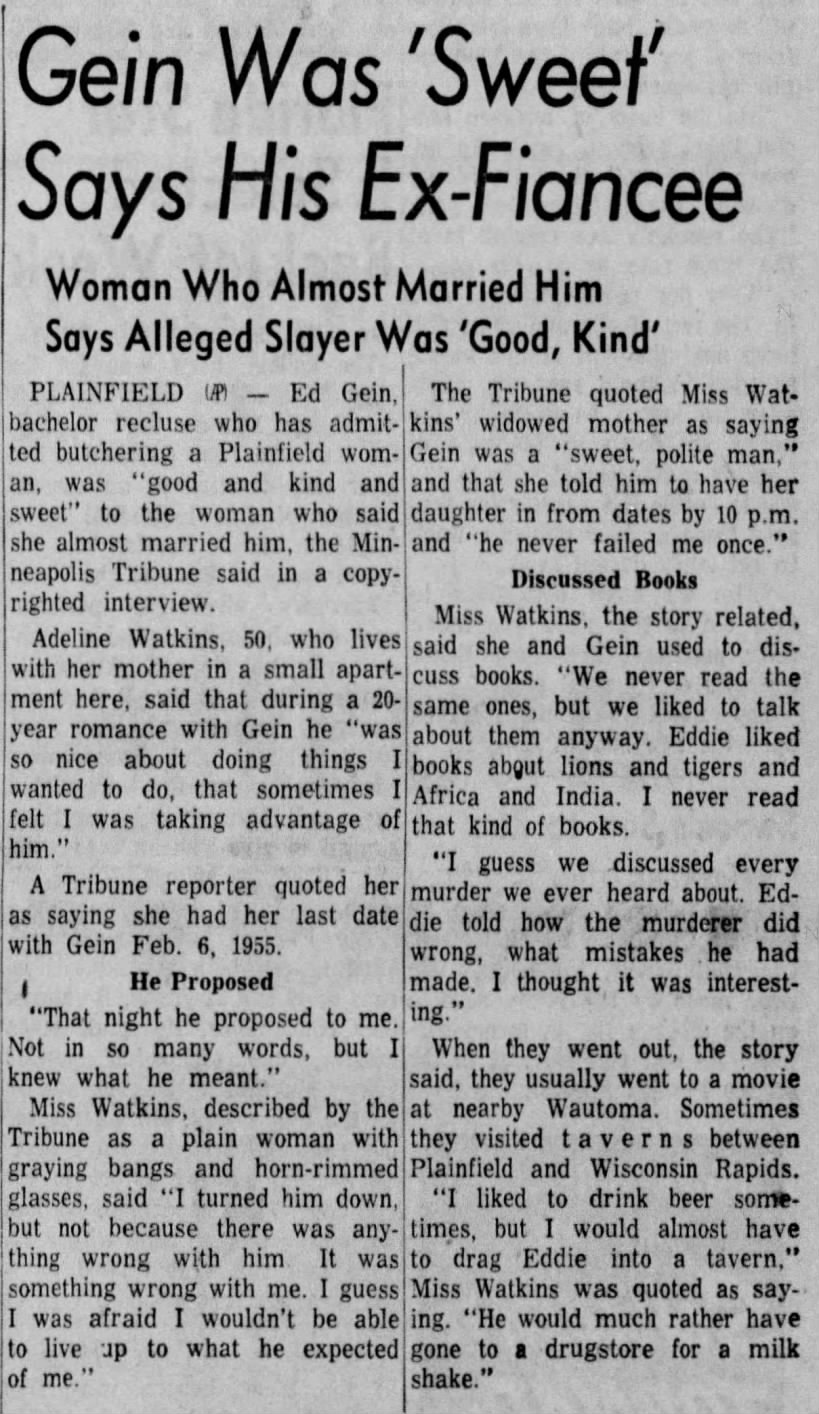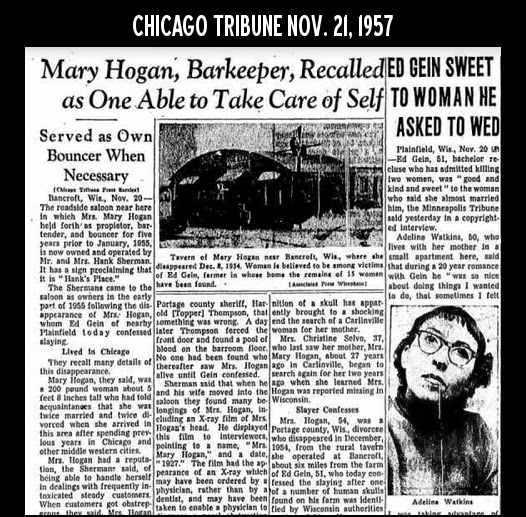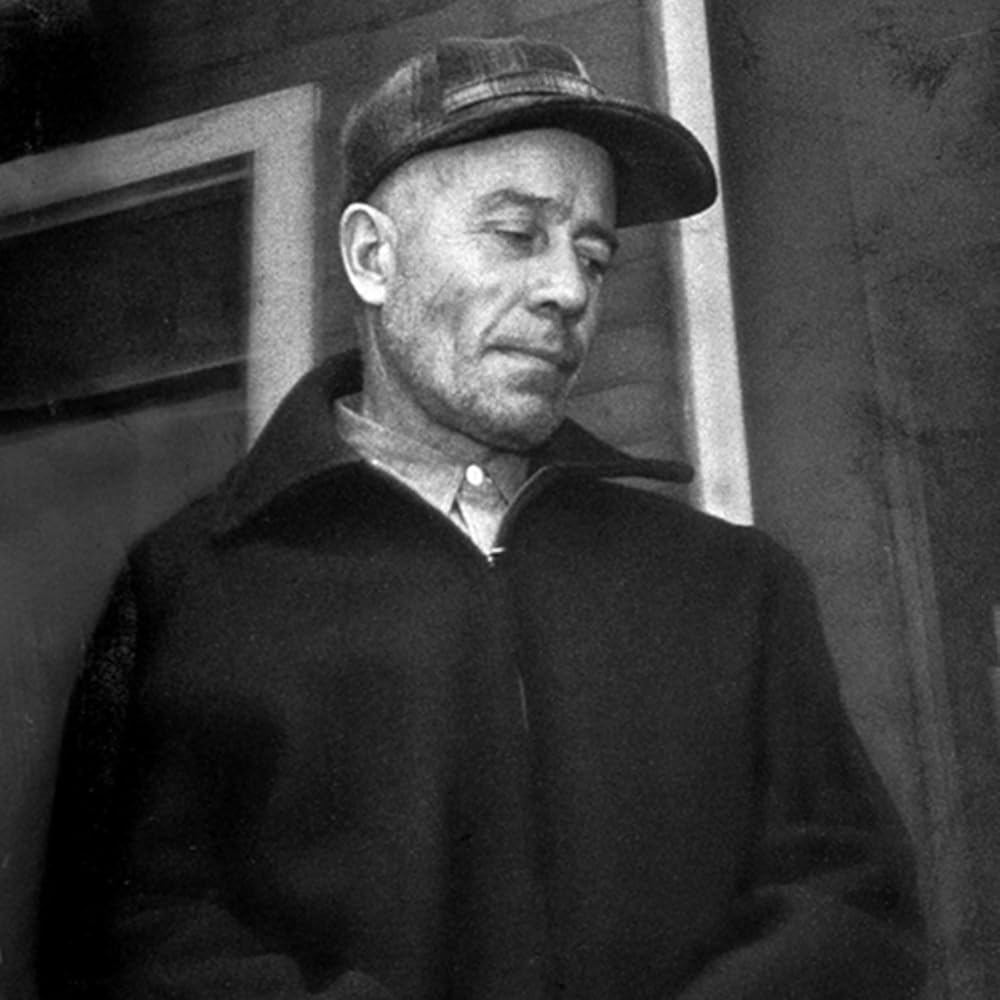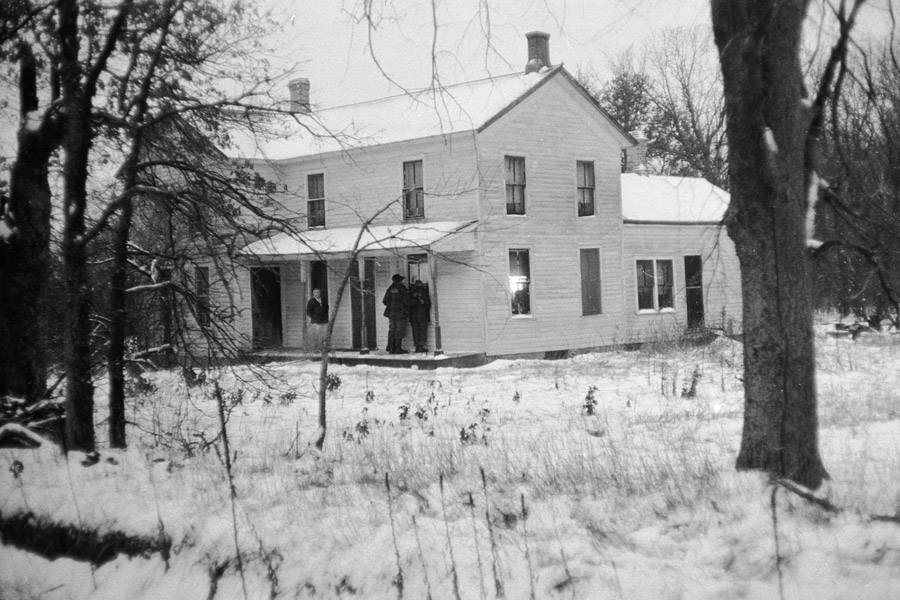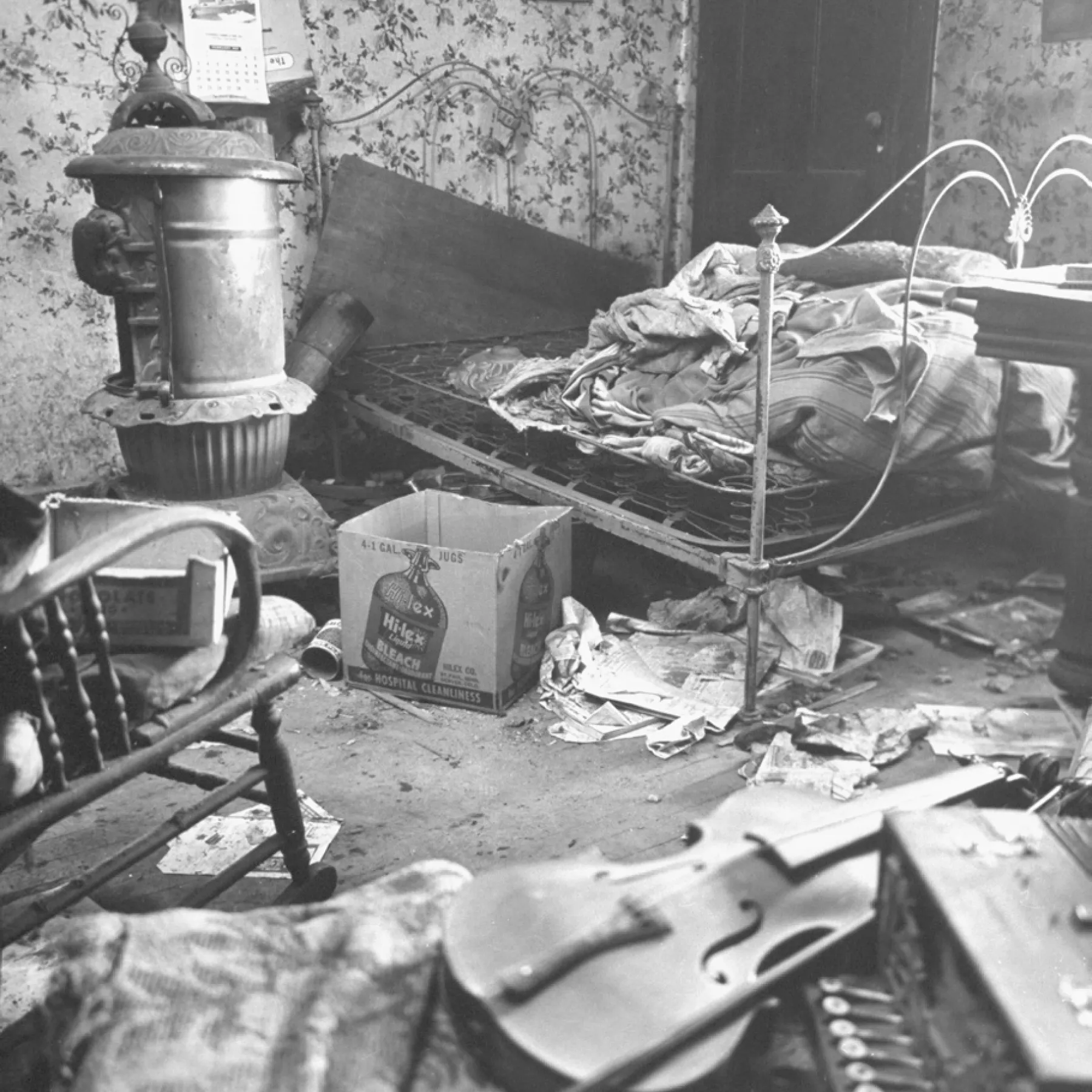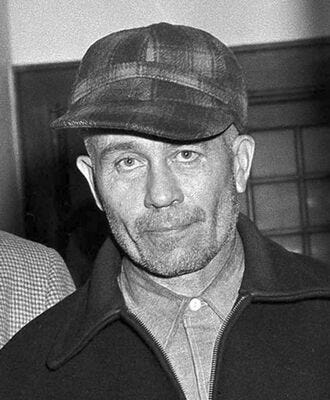Adeline Watkins and Ed Gein: Separating Fact From Fiction
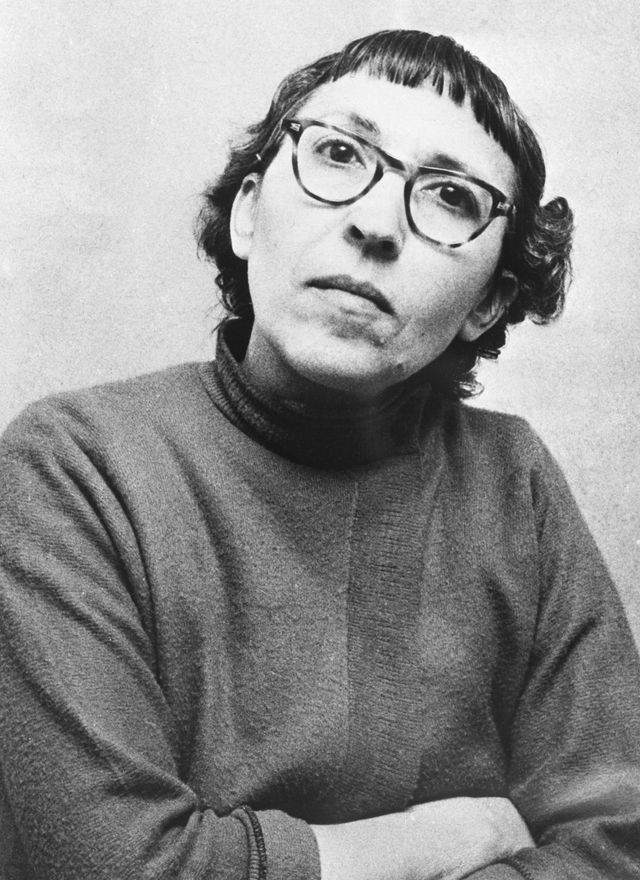
In November 1957, a woman in Plainfield, Wisconsin told reporters she'd been dating Ed Gein for 20 years. She said he proposed. She said they talked about murder. Two weeks later, she said almost none of it was true. So what was real? And what does it tell us about the man who inspired Psycho, The Texas Chainsaw Massacre, Silence of the Lambs, and so many others?
🎧 Listen to the podcast episode about Adeline Watkins
What Did Adeline Watkins Really Claim About Ed Gein?
When police arrested Ed Gein in November 1957, they found something inside his farmhouse that would rewrite the American understanding of horror. Human remains turned into household objects. Skin fashioned into clothing. A body hanging in his shed like a deer carcass. The hardware store owner he'd just killed, Bernice Worden, was only the beginning. Gein confessed to murdering another woman three years earlier and admitted to robbing graves across Plainfield for nearly a decade.
The nation was desperate for an explanation. How does someone like this exist? How does a killer this depraved live among regular people without anyone noticing? And that's when Adeline Watkins stepped forward.
On November 21, 1957, just days after Gein's arrest, newspapers across the country ran a story that stopped everyone cold. The headline in the Wisconsin State Journal read: "Plainfield Woman Nearly Wedded Gein." Adeline Watkins, a 50-year-old woman who lived with her widowed mother in a small Plainfield apartment, told the Minneapolis Tribune that she and Ed Gein had dated for 20 years. She said they went to movies together. They visited taverns. They bonded over books about lions and tigers and faraway places like Africa and India. And here's the part that made everyone's skin crawl: she said they discussed murder cases together.
Then came the proposal. According to Watkins, Gein asked her to marry him during their last date in February 1955. She turned him down, but not because she was afraid of him. She said she just didn't think she could live up to his expectations. Her mother even backed her up, calling Gein a sweet, polite man who always made sure Adeline was home by her 10 p.m. curfew. Watkins herself described the mass murderer as good and kind and sweet.
For the press, this was gold. Here was proof that even a monster could seem normal. That evil could take you to the movies and walk you to your door and say goodnight like a gentleman. It was the story everyone needed to make sense of the senseless.
Except… maybe it wasn't true.
Why Is a 20-Year Romance With Ed Gein Impossible?
Let's do the math. If Watkins and Gein had been dating for 20 years by 1957, that relationship would have started around 1937. And in 1937, Ed Gein was living under the absolute control of his mother, Augusta.
Augusta Gein was not a woman who encouraged her sons to date. She was a fire-and-brimstone religious extremist who believed all women, except herself, were sinful and corrupt. She forbade both Ed and his brother Henry from having any romantic relationships. And Ed obeyed. Everything in his life revolved around pleasing his mother. When Henry once mentioned the possibility of moving out to be with a woman, Ed flew into a rage. The idea of defying Augusta was unthinkable.
So the notion that Ed Gein carried on a public, 20-year courtship while his mother was alive? Psychologically impossible. Historically impossible. The timeline doesn't work. The psychology doesn't work. Something was very wrong with this story.
And two weeks later, Adeline Watkins admitted it.
What Did Adeline Watkins Say When She Retracted Her Story?
On December 3, 1957, the Stevens Point Journal published a follow-up article with a much less exciting headline: "Woman Declares Gein 'Romance' Was Exaggerated."
In this second interview, Watkins walked back almost everything. She said the original Tribune story was blown up out of proportion and contained untrue statements. Yes, she'd known Gein for 20 years, but only as a neighbor. Any actual social interaction had only happened after 1954, when Augusta had been dead for nearly a decade. The so-called courtship? Seven months. And it wasn't even consistent. Gein called on her intermittently during that time. The frequent trips to movies and taverns? A few visits to the Plainfield Theater. That's it.
Watkins also corrected the record on Gein's character. She never called him sweet. She said he seemed quiet and polite, which is very different from good and kind and sweet. And most importantly, she clarified something that should have been a red flag from the start: she was never inside the Gein farmhouse. Not once.
That's a critical detail. Because the Gein farmhouse was where the horror lived. It was the epicenter of his madness. The fact that Watkins never crossed that threshold tells you everything about the nature of their relationship. It was surface level. Transactional. Distant. She was never close enough to see what he really was.
Why Did Ed Gein Reach Out to Adeline Watkins?
So if the 20-year romance was fiction, what was the reality? Based on Watkins' corrected timeline, Gein reached out to her sometime after 1954. That places their brief interaction nearly a decade after Augusta's death in 1945.
This is important because those years after Augusta died were the loneliest and most disturbed period of Gein's life. He was living alone on that isolated farm, spiraling deeper into grave robbing and obsession. By 1954, he'd already murdered Mary Hogan. His crimes were escalating. And yet, during this time, he made what appears to be his only adult attempt at genuine human connection.
That's what makes this so unsettling. Gein didn't reach out to Watkins before he became a killer. He reached out during. While he was actively robbing graves. While he was murdering women. While his house was filling up with human remains. That seven-month period Watkins described wasn't a romance. It was a last, awkward grasp at normalcy by a man who had already abandoned it.
And if he really did propose, which Watkins never fully retracted, it suggests he was trying to anchor himself to something stable. Something ordinary. Maybe he thought a wife could save him from himself. Or maybe he just wanted to see if he could still pass as normal. Either way, Watkins' rejection would have confirmed what Gein probably already believed: he was too far gone for a normal life.
Why Would Adeline Watkins Exaggerate Her Relationship With Ed Gein?
So why did Watkins tell the first story at all? Why claim a 20-year romance that never happened?
The answer probably lies in the chaos of the moment. When Gein was arrested, Plainfield exploded. National reporters descended on the town. Everyone wanted answers. Everyone wanted a story. And Watkins was one of the few people who could claim any kind of personal connection to the man everyone was talking about.
It's possible the exaggeration started with the reporters themselves. They may have heard that Watkins had known Gein for 20 years and assumed that meant they'd been romantically involved for 20 years. Or maybe Watkins, overwhelmed by the sudden attention, played up the connection to make herself part of the story. People do strange things under pressure. And being linked, even tangentially, to one of the most infamous killers in American history creates pressure most people can't imagine.
What we know for sure is that two weeks later, Watkins felt compelled to correct the record. That tells us something. Either her conscience got to her, or she realized the story had spiraled out of control. Either way, the truth was far less dramatic than the headlines suggested.
What Does Adeline Watkins Reveal About How Ed Gein Hid in Plain Sight?
Here's what makes Watkins' story valuable, even with all the exaggeration stripped away. She confirms that Ed Gein was really good at seeming normal. He could show up at someone's house, make polite conversation, take a woman to the movies, and never once raise suspicion. Watkins described him as quiet and polite. Her mother approved of him. He respected curfews. He was, by all outward appearances, harmless.
That's how he got away with it for so long. Gein's horror was entirely internal and entirely hidden. His public persona was so effective that even the woman who spent the most time with him during his killing years never suspected a thing. She never felt unsafe. She was never invited into the farmhouse where the evidence of his crimes was stacked in plain view. He kept those worlds completely separate.
And that's the real takeaway from Adeline Watkins. She wasn't Gein's girlfriend. She wasn't his confidante. She was proof that monsters don't always look like monsters. They look like the quiet guy who asks you to the movies. The polite neighbor who waves hello. The man who makes sure you're home by 10.
Watkins was close enough to become part of the story. But she was never close enough to see the truth. And in a way, that's the most terrifying part of all.


